Related Research Articles

Christian Friedrich Samuel Hahnemann was a German physician, best known for creating the pseudoscientific system of alternative medicine called homeopathy.

James Tyler Kent (1849–1916) was an American physician best remembered as a forefather of modern homeopathy. In 1897 Kent published a massive guidebook on human physical and mental disease symptoms and their associated homeopathic preparations entitled Repertory of the Homeopathic Materia Medica, which has been translated into a number of languages. It has been the blueprint to many modern repertories used throughout the world and even remains in use by some homeopathic practitioners today.

Pedanius Dioscorides, "the father of pharmacognosy", was a Greek physician, pharmacologist, botanist, and author of De materia medica, a 5-volume Greek encyclopedic pharmacopeia on herbal medicine and related medicinal substances, that was widely read for more than 1,500 years. For almost two millennia Dioscorides was regarded as the most prominent writer on plants and plant drugs.
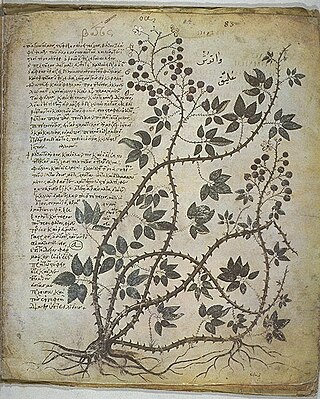
Materia medica is a Latin term from the history of pharmacy for the body of collected knowledge about the therapeutic properties of any substance used for healing. The term derives from the title of a work by the Ancient Greek physician Pedanius Dioscorides in the 1st century AD, De materia medica, 'On medical material'.

Chinese herbology is the theory of traditional Chinese herbal therapy, which accounts for the majority of treatments in traditional Chinese medicine (TCM). A Nature editorial described TCM as "fraught with pseudoscience", and said that the most obvious reason why it has not delivered many cures is that the majority of its treatments have no logical mechanism of action.

The Bencao gangmu, known in English as the Compendium of Materia Medica or Great Pharmacopoeia, is an encyclopedic gathering of medicine, natural history, and Chinese herbology compiled and edited by Li Shizhen and published in the late 16th century, during the Ming dynasty. Its first draft was completed in 1578 and printed in Nanjing in 1596. The Compendium lists the materia medica of traditional Chinese medicine known at the time, including plants, animals, and minerals that were believed to have medicinal properties.

Balm of Gilead was a rare perfume used medicinally that was mentioned in the Hebrew Bible and named for the region of Gilead, where it was produced. The expression stems from William Tyndale's language in the King James Bible of 1611 and has come to signify a universal cure in figurative speech. The tree or shrub producing the balm is commonly identified as Commiphora gileadensis. However, some botanical scholars have concluded that the actual source was a terebinth tree in the genus Pistacia.
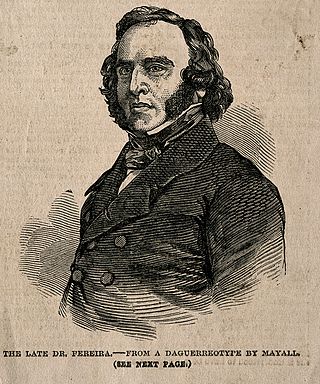
Jonathan Pereira FRS was a pharmacologist, author of the Elements of Materia Medica, a standard work. He was examiner on the subject in the University of London.

Ammoniacum or the gumammoniac is a gum-resin exuded from the several perennial herbs in the genus Ferula of the umbel family (Apiaceae). There are three types of ammoniacum: the gums ammoniac of Cyrenaica, of Persia, and of Morocco.
Li Shizhen, courtesy name Dongbi, was a Chinese acupuncturist, herbalist, naturalist, pharmacologist, physician, and writer of the Ming dynasty. He is the author of a 27-year work, the Compendium of Materia Medica. He developed several methods for classifying herb components and medications for treating diseases.

Diyāʾ al-Dīn Abū Muḥammad ʿAbd Allāh ibn Aḥmad al-Mālaqī, commonly known as Ibn al-Bayṭār was an Andalusian Arab physician, botanist, pharmacist and scientist. His main contribution was to systematically record the additions made by Islamic physicians in the Middle Ages, which added between 300 and 400 types of medicine to the one thousand previously known since antiquity. He was a student of Abu al-Abbas al-Nabati.
Fragmenta de viribus is a homeopathic reference book published in Leipzig in 1805.
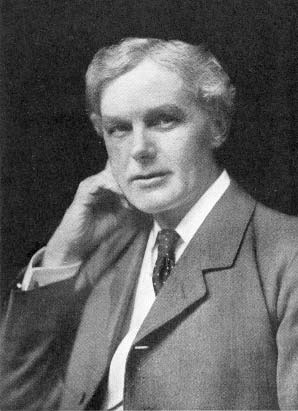
John Henry Clarke was an English classical homeopath, and one of the highest-profile antisemite of his era in Great Britain. He helped found and led The Britons, an antisemitic organisation, from 1919 until his death in 1931. Educated at the University of Edinburgh, he received his medical degree in 1877.
Materia is Latin for "material", and may refer to:
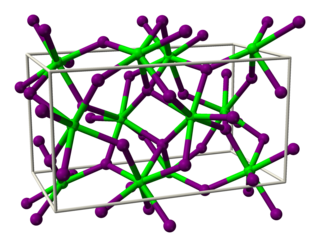
Strontium iodide is an inorganic compound with the chemical formula SrI2. It is a salt of strontium and iodine. It forms a hexahydrate SrI2·6H2O. It is an ionic, water-soluble, and deliquescent compound that can be used in medicine as a substitute for potassium iodide. It is also used as a scintillation gamma radiation detector, typically doped with europium, due to its optical clarity, relatively high density, high effective atomic number (Z=48), and high scintillation light yield. In recent years, europium-doped strontium iodide (SrI2:Eu2+) has emerged as a promising scintillation material for gamma-ray spectroscopy with extremely high light yield and proportional response, exceeding that of the widely used high performance commercial scintillator LaBr3:Ce3+. Large diameter SrI2 crystals can be grown reliably using vertical Bridgman technique and are being commercialized by several companies.
Shennong Bencaojing is a Chinese book on agriculture and medicinal plants, traditionally attributed to Shennong. Researchers believe the text is a compilation of oral traditions, written between the first and second centuries AD. The original text no longer exists, but is said to have been composed of three volumes containing 365 entries on medicaments and their description.
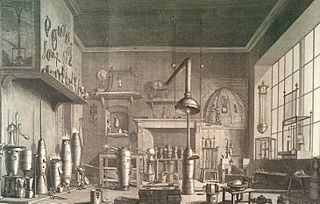
William Lewis FRS was a British chemist and physician. He is known for his writings related to pharmacy and medicine, and for his research into metals.

Johann Friedrich Cartheuser was a German physician and naturalist.

De materia medica is a pharmacopoeia of medicinal plants and the medicines that can be obtained from them. The five-volume work was written between 50 and 70 CE by Pedanius Dioscorides, a Greek physician in the Roman army. It was widely read for more than 1,500 years until supplanted by revised herbals in the Renaissance, making it one of the longest-lasting of all natural history and pharmacology books.
Wang Haogu, courtesy name Haizang, was a Chinese physician and writer. He authored a treatise on insanity and its remedies, in addition to a materia medica that uniquely categorised drugs according to the theory of the wuxing.
References
- ↑ Samuel O. L. Potter (1889). A Compend of Materia Medica, Therapeutics, and Prescription Writing. Philadelphia. p. 36 – via Google Books.
{{cite book}}: CS1 maint: location missing publisher (link) - 1 2 "Alterative". Encyclopaedia Britannica . Vol. 1 (14 ed.). 1930. p. 709.
- ↑ William Davis (February 1895). "Iodine and Its Compounds". Journal of Materia Medica. Vol. 36, no. 2. p. 25.